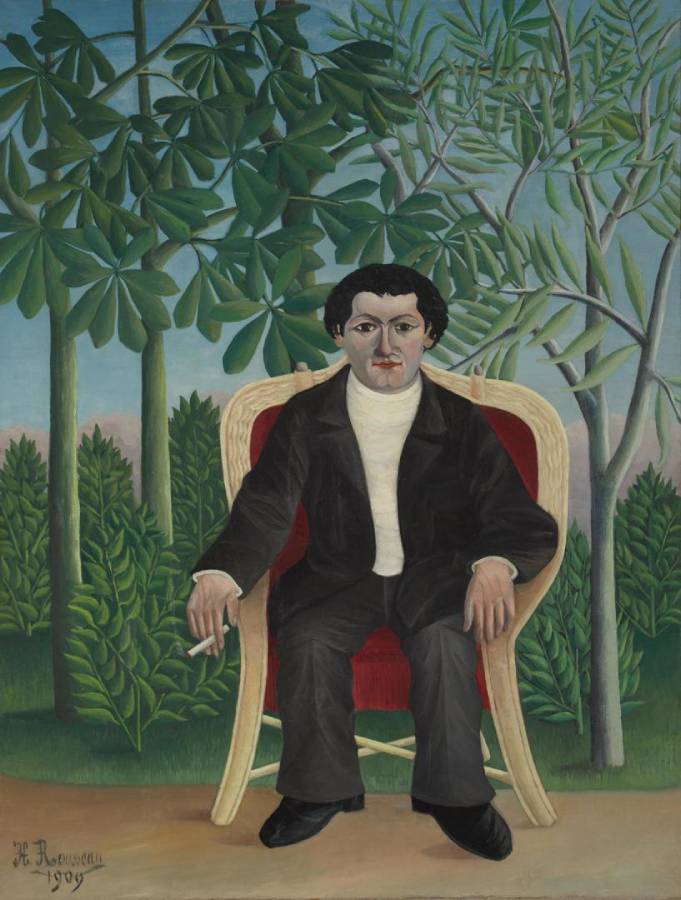Rousseau, Henri (1844-1910)
Portrait de Joseph Brummer (Portrait of Joseph Brummer)
1909
Oil on canvas, 115.9 × 88.3 cm
National Gallery, London
Staring straight at us while nonchalantly holding a cigarette is the Hungarian-born art dealer Joseph Brummer (1883‒1947). The portrait was painted a few months before the opening of his gallery in Montparnasse; the cultural hub of Paris. Exuding a certain confidence, the portrait is fit for a young entrepreneur like Brummer. His gallery dealt mainly in African works of art and paintings by Henri Rousseau. Brummer was one of Rousseau’s most dedicated advocates and patrons, commissioning the portrait from his friend in 1909.
The pioneering Rousseau enjoyed only a few years of critical acclaim. Formerly a customs clerk – hence his often-used nickname ‘Le Douanier’ – he was completely self-taught, taking up painting only in 1883. His primitive works often show elaborate jungle scenes, boasting a vast array of animals and brightly coloured vegetation. His 1891 work Surprised!, also in the National Gallery Collection, is a remarkable example of Rousseau’s characteristic jungle scenes and depicts a startled tiger in a dense forest. Rousseau often visited the Jardin des Plantes in Paris, where he found inspiration in the tropical flora and the caged (wild) animals. Here, he invented his imaginary dreamscapes, composing his jungles from the Botanical Gardens and an array of taxidermy.
The young Joseph Brummer is pictured in a red velvet covered, wicker chair. His hands are placed casually on the armrests of his throne-like seat, with his feet firmly on the ground. He is positioned partly on a sandy path and partly on the grass. Four trees can be seen behind Brummer, in between smaller, more densely leaved bushes. The greenery consists of two layers of leafy plants, leaving space for the ridge of mountains visible in the distance.
Rousseau constructed the painting in his characteristic portrait-landscape genre. As a self-taught artist copying works in the Louvre, it is possible that Rousseau had been inspired by the landscapes in early Italian portraiture, of which the Mona Lisa is a famous example. Rousseau approached the painting’s background layers (in this case, the dense bushes, the four trees and the faraway mountains), as individual elements. In doing so, he plays with the conventional concept of perspective, creating space through the distinct layers of jungle. Even though he was regarded as a pioneer of ‘naïve’ art – referring to his lack of formal education – his understanding of compositional awareness shows his sophisticated and deliberate approach to painting. Rousseau often used his backdrops as a device to hint at his sitter’s identity. The mountains in the background of Brummer’s portrait may suggest the hills of Brummer’s hometown of Zombor (modern-day Serbia).
When Rousseau presented his work The Hungry Lion Throws Himself on the Antelope (Fondation Beyeler, Basel) at the 1905 Salon d’Automne, it was greatly appreciated by his former critics. The work prompted a group of admirers to form around the artist during his later years. Unsurprisingly, the appreciation of Rousseau by younger Avant-gardists coincided with the popularisation of African works of art. Rousseau had a profound influence on the next generation of Modernists, such as Pablo Picasso and Robert Delaunay. As one of his most devout admirers, Brummer held on to his Rousseau works as long as he could. Unfortunately, due to financial troubles, he had to part with his beloved portrait. Brummer sold it to the German art collector, dealer and critic Wilhelm Uhde, who would later publish the first monograph on Rousseau a year after the artist’s death, in 1911. (NG)
See also:
• Brummer, Joseph (1883-1947)
